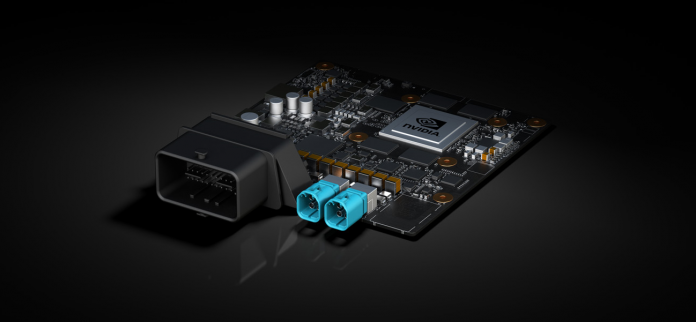Pony.ai announced that its Autonomous Driving Controller (ADC), powered by the NVIDIA DRIVE Hyperion compute architecture (DRIVE Orin), has been sampled to customers with plans to mass produce the ADC starting in Q4 2022.
Since January 2022, Pony.ai has been conducting road tests optimizing the software to run at low latency and with real-time performance. Pony.ai’s autonomous fleets will feature the NVIDIA DRIVE Orin system-on-chip (SoC) as the centralized compute and AI engine.
Pony.ai’s latest ADC offers single or dual NVIDIA DRIVE Orin configurations, delivering 254 and 508 trillion operations per second (TOPS), respectively. As the world’s highest performance automotive-grade SoC, DRIVE Orin is designed to handle large numbers of applications and deep neural networks simultaneously, while achieving systematic safety standards, to ensure safe, highly advanced intelligent driving.
The ADC, along with Pony.ai’s autonomous driving software and hardware, enables vehicles to intelligently and comfortably maneuver on busy city streets, highways, and expressways. This includes following traffic and merging during congestion; automatic lane-changing to follow navigation; and passing cars. It can also safely handle U-turns; identify traffic signals; and unprotected intersections; nudge around construction zones and accidents; identify and interact with vulnerable road users – as well as drive on mixed-use roads, handle on- and off-ramp merges, and automatically pass electronic toll collection gates, etc.
Pony.ai is one of the first in the AV industry to create a product portfolio featuring multiple configurations with one or more NVIDIA DRIVE Orin processors and NVIDIA Ampere architecture GPUs. This product range enables scalable deployment across self-driving trucks and robotaxis and accelerates Pony.ai’s vision of a robust, mass-production platform for AVs.
“By co-developing a turnkey computing platform with NVIDIA, Pony.ai has gained a deep understanding of the characteristics and advantages of NVIDIA DRIVE to rapidly advance our time to market,” said James Peng, co-founder and CEO of Pony.ai. “The impressive real-time performance of Pony’s ADC enables a wide range of applications and deployment,” he said.
“NVIDIA DRIVE delivers the computational horsepower to support the sophisticated AI essential for Pony.ai’s self-driving systems,” said Rishi Dhall, vice president of Automotive at NVIDIA. “As a result, Pony.ai is in a position to create the future of driverless transport that is safer, more reliable and can improve over the lifetime of its robotaxi and robotruck fleets.”
“As our NVIDIA-powered ADC is routinely tested and further integrated at Pony.ai, we’ve entered into a fast technical iteration phase to meet customer demand,” said Tiancheng Lou, co-founder and CTO of Pony.ai. “We are delighted to begin mass production of our proprietary ADC soon — delivering to a wide range of autonomous driving customers.”
Pony.ai develops some of its core hardware in-house. This includes the heterogeneous computing unit based on the NVIDIA chip, which was applied to PonyAlphaX, the company’s fifth-generation autonomous driving system. As of May 2022, Pony.ai has accumulated 13 million (8 million miles) real-world autonomous kilometers, including more than 200,000 driverless kilometers (124,000 miles).
In January 2022, Pony.ai debuted its sixth-generation autonomous driving system design, which has leading-edge sensors, NVIDIA DRIVE compute architecture, and styling and design features for L4 automotive-grade mass production fleets. The first model equipped with Pony.ai’s latest platform, the Toyota Sienna Autono-Maas (S-AM), a seven-seat hybrid electric platform for autonomous mobility, will start road tests in China this year and be deployed within Pony.ai’s public-facing robotaxi operations in the first half of 2023.
Pony.ai began developing DRIVE Orin-based systems with NVIDIA in May 2021, leveraging NVIDIA’s high-performance SoC to accelerate the pace of Pony.ai’s hardware development.

